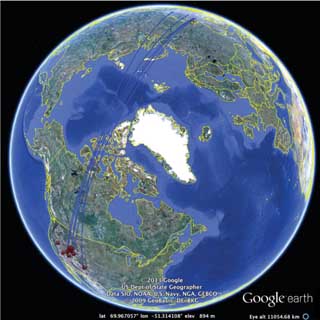
Darren Hart (5736) was busy reviewing data from the previous night’s test of infrasound sensors from a US station that monitors for nuclear detonations at Sandia’s Facility for Acceptance, Calibration and Testing (FACT) site. So when co-workers rushed in to tell him about a meteor the size of a bus that had exploded in a blaze of fire across the western Siberian sky, it was news to him.
“They came in the trailer and asked, ‘Did we pick up the event?’ and I said, ‘What event?’” Darren recalls. “I went over to the station and pulled up the viewer and lo and behold right in the middle of the screen was the event itself.”
Darren saw small disturbances in the atmosphere detected 6,200 miles (nearly 10,000 kilometers) away in the quiet southeast corner of Sandia Labs and about nine hours after the meteor’s explosion, called a bolide. The bolide
occurred 12-15 miles above the Earth and released nearly 500 kilotons of energy. The meteor, which had an estimated mass of 10,000 tons, injured more than 1,000 people, mostly from breaking glass, according to NASA and media reports. It was the largest meteor reported since one hit Tunguska, Siberia, in 1908.
“Any time we can detect coherent signals by our infrasound array and see an event that the rest of the world is seeing, that’s a pretty neat thing to be part of that signal capture,” Darren says. “From the distance, I was a little surprised to have picked it up, but then after hearing of the size, we weren’t as surprised as we initially were.”
Darren ran a simple analysis of the signals from an array of sensors at Sandia and determined the signal came from the north.
Kyle Jones, an infrasound geophysicist in Ground-Based Monitoring Research & Engineering Dept. 5736, is working on a more detailed analysis that could provide data for an international community of infrasound scientists.
Detecting pressure changes
The FACT site infrasound array detected the meteor’s signal at a frequency of less than 1 hertz by the time it reached Albuquerque. Infrasound is the study of sound waves at frequencies inaudible to humans, less than 20 hertz, Kyle says. For comparison, a bumblebee’s buzz is typically 150 hertz and humans hear in the range of 20 to 20,000 hertz.
At FACT, microbarometers — equipment first developed in the early 1900s that today are about the size of gallon milk jugs — are set up in arrays so that each sensor detects the atmospheric pressure change caused by the low frequency sound waves from the meteor’s explosion at slightly different times.
Calculating the varying arrival times here and at other infrasound sensors in the Southwest, Kyle uses geometry to detect the back azimuth, or the direction the sound originated. He says the sound waves detected here passed over the North Pole, which was the shortest distance for the pressure waves to travel.
Kyle also calculated the effects of thermospheric, stratospheric, and surface winds on the sound waves and atmospheric temperature changes that bounce the waves back to the ground multiple times during their journey. He calls this “ray tracing,” which recreates what happened to the sound wave as it was propagating away from the source and toward Sandia’s sensors.
“The fact that the FACT site detected this event at such a great distance and came within 200 kilometers of the source was very, very good,” Kyle says.
Kyle believes the Chelyabinsk bolide is the farthest event the FACT site has ever detected.
“For this type of event, this is probably the limit, but it depends on the winds and the path that the sound is going to take,” he says. “If the winds are favorable winds and the arrays are located at the right spot, it could carry much farther.”
While Sandia’s FACT site is not charged with monitoring nuclear explosions for treaty verification, it does have a research role in supporting the international community’s nuclear monitoring.
Kyle is currently part of a team that is developing software in a research capacity that he hopes both the US and international communities will utilize that uses near real-time wind profiles in its infrasound analysis of suspected nuclear explosions. After Kyle analyzed the wind’s effects on the Chelyabinsk bolide’s sound waves, he reduced the range of the possible location of the explosion by about 185 miles (about 300 kilometers).
‘Seismic is primary’
In the case of the recent meteor, the location was roughly known, but had the explosion happened where no one saw it, for example, over the ocean and unseen by ships, it would have been a mystery, Kyle says, so more accuracy in pinpointing the location would have been necessary.
“The international community uses infrasound as a secondary means of identification of suspected nuclear detonations. Seismic is primary,” Kyle says. “I would say infrasound is important because it’s another piece of the puzzle.”
Infrasound can detect atmospheric detonations and the effects on the atmosphere from underground explosions, he says.
Infrasound also provides the United States with independent verification of what the international community is observing in its monitoring system and “it’s a technology that we can share with them, so they can advance their understanding and they can help us advance ours,” Kyle says.
The FACT site is being expanded from a few acres to sensors across 400 acres and Sandia — with help from DOE, NNSA, the State Department, and KAFB — is helping form a network of infrasound arrays in New Mexico, Arizona, Nevada, Utah and California, called the Southwest US Seismo-Acoustic Network (SUSSAN), which will provide more data to improve the accuracy of autonomously locating all types of infrasound events, both natural and man-made.